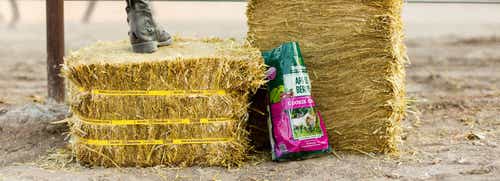
What Do I Feed My Horse? - Managing Forage Part 2
Forage is the most important ingredient in the horse’s diet, yet the choices in forage species and form are sometimes daunting. Understanding the types and physical forms of forage and importance of forage quality will help horse owners choose the best forage to feed their horse.
1. Forage Species
Forage in the form of hay or pasture is the primary ingredient in the diet for most horses. Horses can consume many different varieties of high quality forage, both alfalfa and grasses, without out digestive upset, provided the horse is properly adapted to the forage.
There are many plants that can be grown, cut and stored for use as horse forage. From a practical standpoint, forages can be roughly divided into legumes and grasses. Legumes commonly include alfalfa and clover. Grasses consist of many varieties including: timothy grass, orchard grass, rye grass, bermuda grass, teff grass, blue grass, fescue and many others.
Misconception: Horses can’t eat “pick a variety” forage. I have personally heard that horses can’t eat alfalfa, clover, fescue, bermuda grass, as well as other varieties.
Fact: If forage is properly cut, harvested and stored, horses can eat many varieties of forage. Unless, the horse has a specific allergy or health condition, many different forage choices will suffice.
Solution: Many horse owners choose forage based on what is familiar to them. Then these people move to a different area of the country that raises different varieties of forage. Rather than condemn a forage as evil, talk with your veterinarian or nutritionist to make an informed decision.
2. Pellets, cubes, long stem?
Forage can be processed into a number of physical forms to enhance ease of storage or feeding convenience. Common physical forms include: pellets, cubes, and chopped (chaff) products.
Misconception: Horses will choke on forage pellets or cubes.
Fact: Horses, as well as humans, can choke on any food or feed that is not properly chewed prior to swallowing. Horses can be fed forage in many different physical forms without problems, as long as the rate of intake is monitored. Further, the processing of the forage will not increase or decrease the digestibility of the forage, and it will not influence digestive function.
Solution: The physical form of forage should not prevent you from buying a certain variety of forage. Horses can eat many different physical forms of forage without digestive problems. Regardless of the physical form of forage, all horses should be gradually adjusted to any change in physical form.
3. Carbohydrate Content of Forage
Many horse owners have animals that are sensitive to the sugar and starch content of forage due to diseases such as insulin resistance and laminitis.
Misconception: Alfalfa is high in sugar and starch, and is not appropriate for horses that are sugar-sensitive.
Fact: Alfalfa is actually lower in sugar and starch than many types of grass hay, as sugar is not the primary energy storage unit of legumes. The sugar content of hay is determined by many factors including variety of forage, growing conditions, and harvesting conditions. Cool-season grasses store carbohydrate as sugar and are naturally high in sugar.
Solution: If your horse is sensitive to the sugar content of the diet, all forage should be tested for sugar content prior to feeding any variety. Simply believing that one type of forage is better than another is not the answer.
Forage Finder & Feed Calculator
Be sure to use our online tools: FORAGE FINDER | FEED CALCULATOR
In summary, it is difficult to say definitively that your horse should eat this type or that type of forage. It is important to first select a clean forage that is free of mold, dirt, weeds or other contaminants. Then ask questions about the carbohydrate content – will this forage be low enough in carbs for my horse? Remember the sugar and starch content of grass is primarily dictated by the environmental and soil conditions during the plant's growth and harvesting. Simply saying I only feed “timothy” or “first cutting” because its lower in sugars and starches is not true. The only true test of carbohydrate content in forages is laboratory analysis.
Second, look at the physical form and if your horse can eat it. Does he have poor teeth and can’t chew long stem hay? Then a pellet or cube (soaked) may be more appropriate for your horse. If your horse is overweight, select a forage with less calories that may have a slightly higher fiber component.
Finally, remember all horses should eat approximately 1.5 to 2% of their body weight in forage per day. No matter if the horse is aged, exercising, sedentary, or sugar and starch sensitive, it is still critical to feed this amount of forage. Find detailed feeding instructions here.
By Dr. Tania Cubitt & Dr. Stephen Duren
Standlee Nutritional Experts - Performance Horse Nutrition











